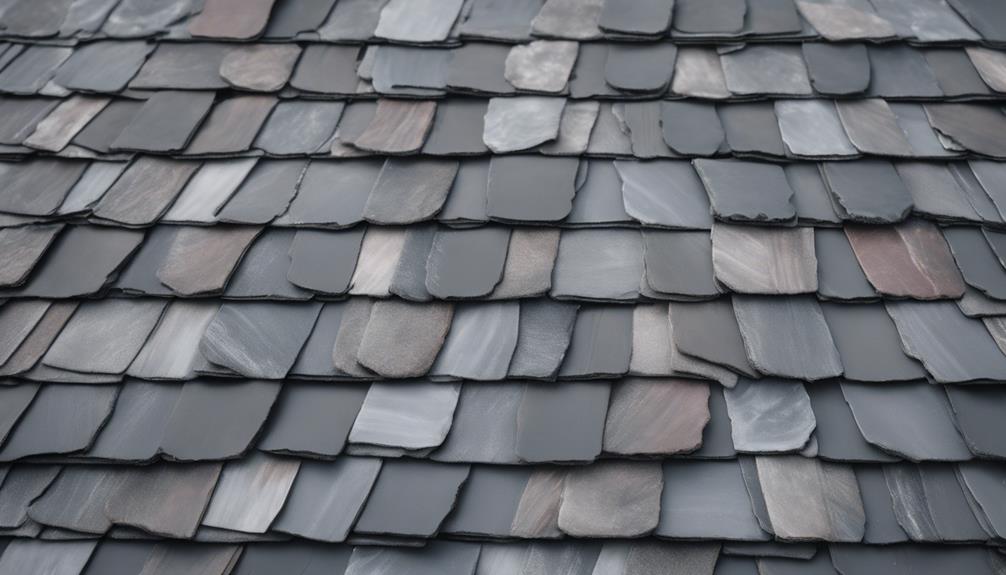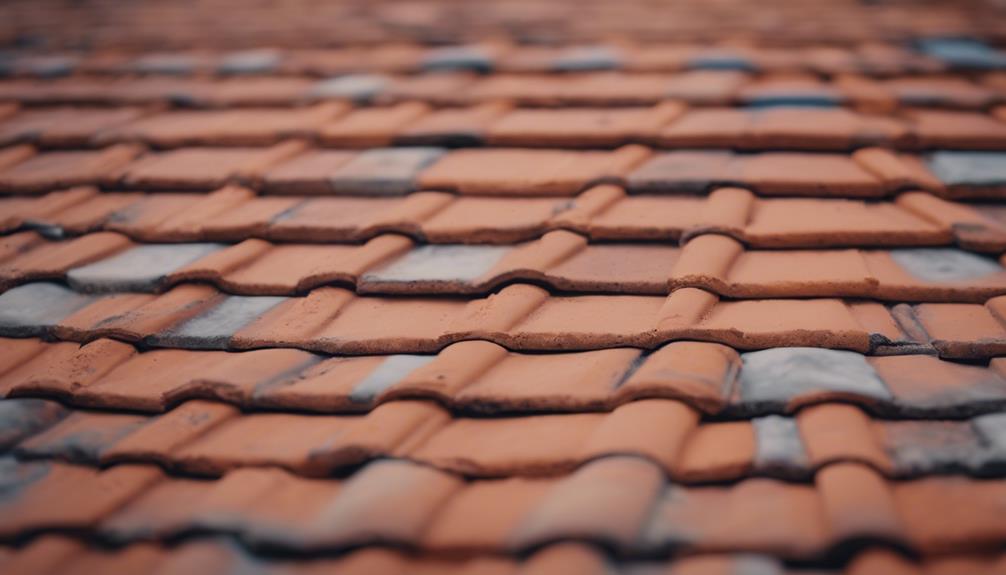What Are the Different Types of Roof Tiles?
Step into the diverse world of tile roofing and discover the surprising secrets behind each option - a journey worth exploring further.
Exploring tile roofing offers a wide range of choices, each with its own strengths and considerations. You have the option to choose different types of roof tiles such as clay tiles, metal tiles, concrete tiles, and slate roof tiles.
To make a smart choice, it’s important to understand what sets each type apart. It’s not just about how they look; factors like how long they last, how much upkeep they need, and their impact on the environment are also key in choosing the right roofing material.
Stay with us as we break down the details of different tile roofing types and guide you through this important decision.
What Is Clay Tile Roofing?
Clay tile roofing, a traditional and durable roofing material, has been utilized for centuries due to its aesthetic appeal and longevity. These terracotta tiles are crafted from natural clay that is moulded, glazed and fired in kilns at high temperatures to create sturdy roofing materials. The distinctive terracotta colour of clay tiles adds a charming and timeless look to a variety of architectural styles, from Mediterranean to Spanish Colonial.
One of the key advantages of clay tile roofing is its exceptional longevity, with a lifespan that can exceed 100 years when properly maintained. Additionally, clay tiles are highly resistant to fire, insects, and rot, making them a reliable choice for homeowners seeking a durable home renovation roofing option.
While the initial cost of clay tile roofing may be higher than some other materials, the long-term benefits considering durability and aesthetic appeal often outweigh the upfront investment.
Advantages of Clay Tiles:
- Durable
- Fire-resistant
- Aesthetically pleasing
Disadvantages of Clay Tiles:
- Heavy
- Expensive
- Brittle
What Is Concrete Tile Roofing?
Concrete tile roofing is a popular alternative for homeowners seeking a reliable roofing solution, that offers durability and a unique aesthetic. Made from a mixture of sand, cement, and water, concrete tiles are known for their strength and longevity. It can even mimic other tile materials such as slate and wood.
Concrete roof tiles outperform other popular roofing materials in terms of durability and performance. Concrete tiles are more durable and last longer than asphalt shingles, with a lifespan of 50 to 100 years when properly installed. They also offer better resistance to high winds, hail, and fire than wood or metal roofing materials.
Concrete tiles provide excellent insulation properties, helping to regulate indoor temperatures and reduce energy costs. To ensure a long-lasting concrete tile roof, perform regular checks for damaged, missing, or loose tiles. Replace them promptly to prevent further damage. Many manufacturers offer limited lifetime warranties, providing added peace of mind.
Advantages of Clay Tiles:
- Durable
- Versatile
- Cost-Effective
Disadvantages of Concrete Tiles:
- Heavy
- It requires additional structural support
- It needs periodic cleaning and inspection
What Is Slate Tile Roofing?

Slate tile roofing, known for its elegance and longevity, is a premium roofing option that offers exceptional durability and a sophisticated aesthetic appeal. It is made from natural stone and it is renowned for its beauty and can enhance the overall look of a property. These tiles are available in various sizes, thicknesses, and colours, allowing for customization to suit different architectural styles.
Slate roofs are known for their longevity, with some lasting over a century when properly maintained. While the initial cost of installation might be higher compared to other roofing materials, the long-term benefits often outweigh the upfront investment. Proper installation by experienced professionals is important to ensure the longevity and performance of a slate tile roof.
Advantages of Slate Tiles:
- Long-lasting, can last over 100 years
- Natural-looking tiles
- Low maintenance
Disadvantages of Slate Tiles:
- Heavy
- Expensive
- Often difficult to install
What Is Metal Tile Roofing?
Metal tile roofing is commonly used for roofing, wall cladding, and backsplashes due to its durability and resistance to corrosion. Metal tiles come in a variety of shapes, sizes, and finishes, allowing for endless design possibilities in both residential and commercial spaces. Their reflective surfaces can also help to enhance natural light in a room, making spaces feel brighter and more spacious.
Metal tiles’ finishes and colours significantly impact their aesthetic. Various finishes are available, including brushed, polished, hammered, and aged, each with a unique visual effect. Brushed finishes appear matte, polished finishes are reflective, hammered finishes are textured, and aged finishes convey vintage sophistication.
Metal tiles can greatly enhance a room’s aesthetic, particularly in high-traffic areas like kitchen backsplashes and bathroom walls. They add a versatile and textural design element to walls and floors, elevating the overall visual appeal.
Living rooms and outdoor spaces can gain a stunning visual effect from metal tiles, adding brightness and reflectivity. With their ability to mimic various metal finishes, metal tiles can create a cohesive look throughout a home. They can be used as an accent wall or statement piece, adding modern sophistication to any room.
Metal tiles require proper maintenance and care to preserve their appearance and performance. Regular cleaning with a mild dishwashing detergent and warm water prevents dirt and grime buildup, which can dull the finish. Microfiber cloths should be used to avoid scratching the surface, and thorough rinsing is necessary to prevent residue buildup.
Advantages of Metal Tiles:
- Durable, can last 40-70 years
- Lightweight
- Modern look
- Recyclable
- Cost-effective
Disadvantages of Metal Tiles:
- It can produce noise when it rains or other weather extremes
- Higher potential for rusting than other tiles
How to Choose the Right Tile Roofing Material?

When contemplating the selection of the right material for your tile roofing, it is important to factor in key elements that align with your specific requirements and preferences.
One important aspect to take into account is the durability of the material, ensuring it can withstand the weather conditions prevalent in your area. Additionally, look into the maintenance requirements of the material to ensure it suits your lifestyle and budget.
Another important factor is the aesthetic appeal of the tile, as it should complement the overall look of your property. To further assist you in making an informed decision, here is a table outlining some key considerations when selecting the right material for your tile roofing:
| Consideration | Description | Importance Level |
|---|---|---|
| Durability | The ability of the material to withstand environmental factors | High |
| Maintenance | Time and cost required to upkeep the roofing material | Medium |
| Aesthetic Appeal | How well the tile complements the property’s overall look | High |
Frequently Asked Questions
Are There Any Special Installation Techniques or Considerations for Tile Roofing in Areas With High Winds or Frequent Storms?
In regions prone to high winds or frequent storms, special installation techniques should be employed for tile roofing. This includes using specific fastening methods, reinforcing with additional materials, and ensuring proper sealant application to enhance durability and prevent damage.
How Long Can I Expect a Tile Roof to Last Compared to Other Roofing Materials?
Tile roofs can last 50-100 years, surpassing other materials like asphalt shingles or wood shakes. Their longevity is due to durability against weathering and fire, making them a premium investment for homeowners seeking long-term protection.
Are There Any Specific Maintenance Requirements for Different Types of Tile Roofing?
Maintenance requirements for different types of tile roofing vary. Concrete tiles may need periodic cleaning to prevent algae growth. Clay tiles may require resealing to maintain water resistance. Regular inspections and repairs are essential to guarantee longevity and performance.
Can Tile Roofing Be Easily Repaired if a Few Tiles Are Damaged or Broken?
Tile roofing can be easily repaired if a few tiles are damaged or broken. It typically involves removing the damaged tiles, replacing them with new ones, and ensuring proper alignment and sealing to maintain the roof’s integrity and functionality.
Are There Any Specific Considerations or Limitations When It Comes to Adding Solar Panels or Other Rooftop Additions to a Tile Roof?
When adding solar panels or other rooftop additions to a tile roof, it is essential to ponder the weight-bearing capacity of the roof structure. Proper installation methods are vital to prevent damage to the tiles and maintain the roof’s integrity.